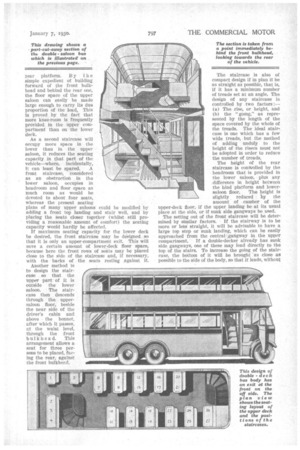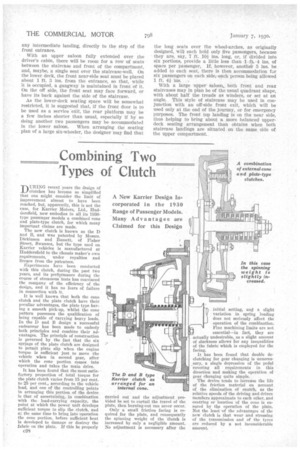The Chances for the
Page 58

Page 59

Page 60

If you've noticed an error in this article please click here to report it so we can fix it.
TWIN-STAIRCASE DOUBLE-DECKER
Our Bodybuilding Expert Puts Forward Several Good Reasons in Favour of the Adoption of a Second Stairway
With the coach, the front door is usually the main entrance and the rear one an emergency exit. On the other hand, the singledecker is nominally a rearentrance vehicle and the front entrance is used, as a rule, as an exit, to facilitate during busy periods the setting-down of passengers.
If the double-decker is to have another door, it may consist of a front exit only to the lower deck.. This door will relieve the rear platform of a certain amount of congestion. A pair of hinged doors, or one folding in half, with its accompanying landing space, takes up about as much floor area as does a couple of seats and, being on the near side, can be used as often as the occasion demands.
If it be set out between two seats facing one another, a coach-type of door need not reduce the seating capacity. The door can be hung either on the near or off side and would, in most instances, be regarded as an emergency, rather than as a service exit.
The lower deck, however, doe S not require additional unloading facilities so much as does the upper c36 deck. The passengers on the upper saloon have a staircase, as well as a longitudinal gangway, to negotiate, the former tending to retard the rate of progress towards the exit. Furthermore, the upper deck is not usually provided with the wide gangway that is a common feature of the rear part of the lower saloon. Moreover, there are usually more seats in the upper saloon, so that if the double-decker is to have another doorway it should give access to the upper compartment and, therefore, the question of a second staircase has to be considered.
The chief difficulty with regard to the extra staircase is that it directly affects the ratio of the upperdeck seating capacity to that of the lower saloon. The ratio recommended by the'Minister of Transport is eight upper-deek seats to seven lower ones. The lengtn .of the lower saloon is decided by the position of the front bulkhead and the space allotted to the
rear platform. By the simple expedient of building forward of the front bulkhead and behind the rear one, the floor space of the upper saloon can easily be made large enough to carry its due proportion of the load. This is Proved by the fact that more knee-room is frequently provided in the upper compartment than on the lower deck.
As a second staircase will occupy more space in the lower than in the upper saloon, it reduces the seating capacity in that part of the vehicle—where, incidentally, it can least be spared. A front staircase, considered as an obstruction in the lower saloon, occupies in headroom and floor space as much room as would be devoted to about four seats, whereas the present seating plans of many upper saloons could be modified by adding a front top landing and stair well, and by placing the seats closer together (whilst still providing a reasonable amount of comfort) the seating capacity would hardly be affected.
If maximum seating capacity for the lower deck be desired, the front staircase may be designed so that it is only an upper-compartment exit. This will save a certain amount of lower-deck floor space, because here the front rows of seats may be placed close to the side of the staircase and, if necessary, with the backs of the seats resting against it.
Another method is to design the staircase so that the upper part of it is outside the lower saloon. The staircase then descends through the uppersaloon floor, beside the near side of the driver's cabin and above the bonnet, after which it passes, at the waist level, through the front bulkhead. This arrangement allows a seat for three persons to be placed, facing the rear, against the front bulkhead. The staircase is also of compact design if in plan it be as straight as possible, that is, if it has a minimum number of treads set at an angle. The design of any staircase is controlled by two factors :- (a) The rise, or height, and (b) the "going," as represented by the length of the space covered by the whole of the treads. The ideal staircase is one which has a few wide treads, but the method of adding unduly to the height of the risers must not be adopted in order to reduce the number of treads.
The height of the rear staircase is conlvolled by the headroom that is provided in the lower saloon, plus any . difference in height between the hind platform and lower saloon floor. The height is slightly reduced by the amount of camber of the upper-deck floor, if the upper landing be at its usual place at the side, or if sunk side gangways be used.
The setting out of the front staircase will be determined by similar factors. If the stairway is to be more or leSs straight, it will be advisable to have a large top step or sunk landing, which can be easily approached from the central.:_gatigway in the upper compartment. If a double-decker already has sunk side gang-ways, one of these may lead directly to the top of the stairs. To increase the going of the staircase, the bottom of it will be brought as close as possible to the side of the body, so that it leads, without any intermediate lauding, directly to the step of the froat entrance.
With an upper saloon fully extended over the driver's cabin, there will be room for a row of seats between the staircase and front of the compartment, and, maybe, a single seat over the staircase-well. On the lower deck, the front near-side seat must be placed about 1 ft. 3 ins, from the entrance, so that, while it is occupied, a gangway is maintained in front of it. On the off side, the front seat may face forward, or have its back against the side of the staircase.
As the lower-deck seating space will be somewhat restricted, it is suggested that, if the front door is to be used as a service exit, the rear platform may be a few inches shorter than usual, especially if by so doing another two passengers may be accommodated in the lower saloon. When arranging the seating plan of a large six-wheeler, the designer may find that the long seats over the wheel-arches, as originally designed, will each hold only five passengers, because they are, say, 7 ft. 101 ins, long, or, if divided into six portions, provide a little less than 1-ft: 4 ins, of space per passenger, If, however, another 5 ins, be added to each seat, there is then accommodation fc,tsix passengers on each side, each person being allowed 1 ft. 4/ ins„ With a large upper saloon, both front and rear staircases may in plan be of the usual quadrant shape, with about half the treads as winders, or set at an angle. This style of staircase may be used in conjunction with an off-side front exit, which will be used only at the end of the journey, or for emergency purposes. The front top landing is on the near side, thus helping to bring about a more balanced upperdeck seating arrangement than obtains when both staircase landings are situated on the same side of the upper compartment.,












































































































